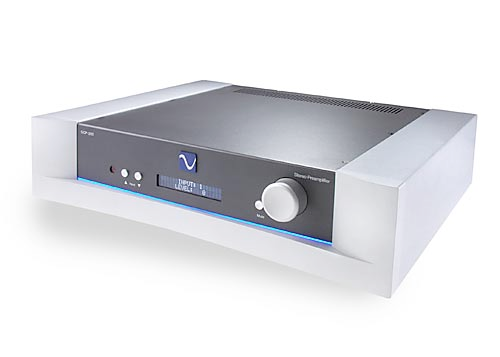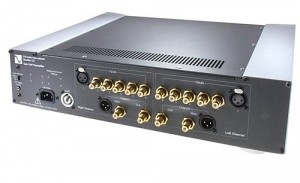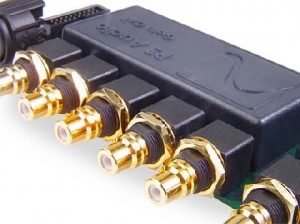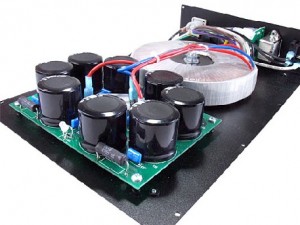PS Audio is a name that has been around now for several decades, in one form or another, even disappearing for awhile before coming back again headed up by chief Paul McGowan (the P of PS), who brought the company name back into existence with a range of new power products in the late1990s. Most people now associate the company with its well-regarded range of line conditioners, cables, and perhaps with their latest range of half-sized gain cell amps amps and DACs that have garnered positive reviews far and wide. PS Audio also offers a range of full-sized amplifiers, covering all the bases: integrated, two-channel and multi-channel power amps and, the subject of this review, their stand-alone preamp, the GCP-200.
Specifications:
- 6 inputs
- HT Bypass
- Polarity control
- 5 RCA 1 XLR
- Separate subwoofer output XLR output and RCA output Remote control
- Programable gain for each channel
- Price: Starting at $2195
Preamps are the router of an audio system, receiving the signals from front-end components, switching then usually amplifying them sufficiently for the power amplifier to provide the necessary current to drive the speakers. There’s a certain historical element to the use of separate preamps; if one were designing audio systems from scratch today, you might wonder if this separation from power amplification or even the originating component was ideal, but audio is nothing if not a continuous refinement of historical positions on the mechanics and engineering of sound reproduction.
PS Audio GCP-200 review
The GCP-200 is an unusual preamplifier. It is fully balanced from input to output, and unlike other designs, it employs what PS Audio terms ‘gain cell’ technology, a current-based alternative to the use of gain blocks with potentiometers and attenuators working on voltage. PS Audio claims it as a world’s first, producing a super-quiet, ultra clean signal line that provides controlled gain without the use of feedback or signal rejection, and while the exact details remain proprietary, their argument is that you achieve purer signal amplification through this technology than is possible with any other form. The gain cell especially allows for identical sounding output at all volume levels, so there is no sweet zone within which it sounds best (apart from your own taste for volume).
I put the GCP-200 to work in my system, replacing my long serving McCormack TLC-1, a superb preamp that represented state of the art performance in the early to mid-90s. Able to run passive or active (‘buffered’ as McCormack put it), the TLC-1 proved a zero-maintenance, easy on the ear preamp that took what you fed it and passed it along with sufficient (voltage) gain to drive a power amp in a most unfussy manner. Of course, if you believe the theory, a preamp in passive mode would have to be better, all things being equal, than in active, but I found over several years of use that I actually preferred the TLC-1 in buffered mode. This could be attributable to familiarity, since at first I used it to drive 40ft of interconnect in a long room where the passive outputs just did not match the actives. However, when I moved to my current house, I set my audio system up with the preamp and power amp next to each other and then switched to passive, assuming this would be better. It was some time before I felt something was missing and, upon switching back to buffered outs, the music as I liked it came back. Preference or performance? Who can say for sure? I ended up leaving it where I liked it. Having listened to it for over 7 years, I know its strengths and always felt it would take something special to replace it in my system.
Room, Set up and Features
My room is 25’x18’x8’, with a hardwood floor covered by a 15×12 rug in the listening area. One long wall is largely windows, the other covered with shelves holding books, LPs and CDs, with a doorway towards the rear end. The front wall is wood paneled and the system sits on the stone fireplace, with speakers sitting 27” from wall to rear, 38” from wall to side. Rear wall is some 8 ft behind my head, containing two large openings either side. All gear save my oversized BAT power amp sits on a Lovan rack, with the turntable sitting on an extra thick self-made MDF shelf on top.
The GCP-200 arrived well packed and proved simple to install within minutes. It has one pair of balanced and 5 pairs of single-ended inputs. It offers two pairs of both balanced and single-ended ouputs, providing a tempting option for biamping in the future. An auxillary out is provided for subwoofers, as is a HT by-pass feature if you care to use it (I did not) , and a cheap-feeling remote control that allows for input selection, volume control and phase control if you think a recording is off. I am not a big admirer of the look of current PS Audio products, particularly this preamp, which to my eyes is somewhat industrial, plastic, and computer-like (the remote in particular feels like a throwaway), but this is a matter of taste; I know others love it. You might too, so I’ll leave it at that. The inputs are programmable with a few button presses, so you can name, say, Input 1 as SACD, Input 2 as Vinyl, and for each input, you can set a default volume level so that switching inputs produces a smooth transition without further need to fuss with the volume control. Since I am the kind of guy who likes to get up and fiddle with the controls when I change a record or disc, this was not a major advantage for me, but I can imagine others will really like that feature. You can also set the blue light on the front display to varying levels of brightness. I set it to its lowest, which defeats the horizontal lighting strip across the front, leaving only the display of input and volume level showing. The volume level can be set precisely on a scale from 0-100, and I nearly always ended up around 37 in my regular listening.
How does GCP-200 sound?
Ideally, a preamp has no sound. It should just let the signal through, untouched by anything but gain, and this is the challenge in comparing designs. The winner should do less, so to speak. At more than twice the price of the TLC-1 (when I bought it!) I anticipated a significant step up, and confess to being initially under-whelmed. Sure, it sounded pretty good, as much as I could talk about it having a sound, the music emerging cleanly, perhaps a little better than with the TLC-1 but not in a way I could easily put my finger on, or in a manner that jumped out at me. The GCP-200 is eerily quiet, and the volume control has an extremely light feel that gives little tactile feedback as you turn it, which adds to the experience of this as a different product. Even turned up full, there is not a hint that anything is on and you can press your ear to the speaker without knowing if the system is turned on or off.
I listened closely to a range of recordings for several days trying to characterize the differences. Playing Ronnie Earl’s Grateful Heart CD, one of my long term references and a soulful combination of guitar, organ, saxophone, bass and drums, the music seemed to open up in the bass area particularly, as if the whole presentation was extended by the removal of a floor that I’d previously never noticed. Perhaps there was a hint of greater resolution, maybe the saxophone was a little more lifelike and present, or could it be I was trying to hear such differences in those areas? Floor aside, that’s how subtle the changes seemed, I had to really listen to determine them, but the band sure sounded just a little larger. It was not easy to say what exactly, but something had changed and to my ears it was positive. My wife asked me if I could tell the difference, as she could not. I trust her ears, at least as a reality check for me on the magnitude of differences components might introduce, since audiophiles have a willing tendency to magnify the trivial into the significant. But in all cases, it was as if the sound took up more space in my room, emerging from a larger stage, be it classical, chamber, jazz or rock. That floor had just been lowered. I heard it but she didn’t. You draw your own conclusions.
Note, at this point I was using the same single-ended MIT T3 interconnects with both preamps and not taking advantage of the balanced inputs/outputs available on the GCP-200. After a few weeks of this, certain the preamp was operating as well as it would in this set up, I purchased a pair of PS Audio Resolution XLR interconnects on the recommendation of folks who use PS Audio amps. This cable produced another slight improvement to my ears. Popping the MIT back in, I confirmed this change. Now there seemed no doubt that the resolution was finer: small details I’d never paid attention to or noted on old, familiar recordings seemed to emerge. On Roger Waters’ CD Amused to Death, I actually heard that quartet in Vienna (mentioned by the narrator at the outset) show up for once on my right speaker, where before it had never materialized meaningfully from the background cacophony of war memories, as if caught quickly by a radio as you turn the tuning dial. This recording is full of tiny details, musical and otherwise, and it was a pleasure to hear it afresh, which is what happened here. With more acoustic music, such as Starker’s Unaccompanied Cello Suites on SACD, the timbre of the cello seemed truer, better presented and more lifelike. If I were to leave it at this I’d probably have concluded that the GCP200 offered a small step upward in my endless climb to sonic nirvana. At $2100, I’d hoped for more but I am hard to impress, I am not sure any preamp is significantly better than a TLC-1 at this price point, a fact I attribute to the quality of the McCormack preamp which, even though more than a decade old, competes easily with current designs.
As an aside, you might ask–quite reasonably in my view–just how much progress are we making in audio? Putting marketing and magazine reviews aside, I would suggest that dollar for dollar, new designs are never guaranteed to improve on old ones, and claims for major advances should be thought of better as possibly opening the window just a little wider. If you were starting a system from scratch today, I’d say you could create a killer set up with well-priced used components, if you bought wisely.
So, on its own, with balanced cables, the GCP-200 is very good, but perhaps not great. However, this preamp comes with an option, an external power supply with a dedicated Neutrik connector that promises a step up in performance, albeit for another grand in cost. Springing for PS Audio products is straightforward, since they offer a no-quibble 30-day trial period on everything they sell (other than made-to-order multichannel amps of unusual configurations), so a couple of weeks further into listening to the GCP-200 run balanced with the BAT, I added the optional $999 external power supply. The combined cost of the preamp with power supply crosses $3000, and for this kind of money one has every right to expect unambiguous improvements (and, perhaps, to question if such a price takes it beyond most people’s idea of ‘affordable’, but I digress).
In my view, this combination just plain works. It is not that the power supply transforms the sound beyond recognition it does not–but it does take it another clear step further and, consequently, offers a rightness of delivered sound that makes the power supply, for me, an essential, rather than optional, partner to the GCP-200. The improvements I experienced originally over the TLC-1 were now stretched a good bit further. Music seemed to come into sharper focus, the instruments distinctive and more present in my listening room. Again, on Starker’s first recording of Bach’s Unaccompanied Cello Suites, the strings had a tactile nearness as if you were sitting closer to the action, Starker’s bowing technique becoame more discernible, and the body of the instrument resonated with more realism than before. The Emerson Quartet’s recording of Bach’s Art of the Fugue provides any system with a chance to show its resolving power, and the preamp combo handled the intertwining instrumental lines with aplomb. If I had to choose one word to describe the primary effect, comparing the fully tricked out GCP-200 preamp with its predecessor, ‘openness’ came to mind. The sonic picture had greater clarity, more frequency extension, particularly at the lower end, more tangibility, and as a result, there was a better sense of what the musicians were doing. Preamp reviewers always talk of a window being more transparent or of veils being lifted, and with good reason. Clichéd as it sounds, this is very much the effect one experiences when the line from source to speaker is improved. With vocals, this improvement manifested itself through the presentation of small details that gave greater flesh and body to the singer. Holly Cole (Temptation) seemed to move a little closer (one can wish!) and I found it easier to imagine a living, breathing woman calling me a ‘silly boy.’ On rock music, if well recorded, there seemed to be greater drive to the rhythm section, and lead lines were more discernable, more easily separated from the instrumental backing. Jon Lord’s Hammond playing on Deep Purple’s wonderfully remastered Machine Head (EMI) has vibrant tonal qualities that now seemed a easier to hear, and the music took on a freshness and life that better revealed the intricate interplays between the lead musicians and the good time swing of the band at play.
But this clear window exposed limitations when fed poor recordings. James ‘Blood’ Ulmers’ Blues Preacher (Columbia, CD) is an engaging, guitar-driven mix of jazz, psychedelic blues and rock that I always thought of as a weak recording of a great artist, but with the GCP I just think it sounds like a third generation cassette copy borrowed from a friend, and just as unlistenable. If you want to sweeten such recordings, try a tube amp. For better or worse, the GCP-200 offers them nowhere to hide.
Perhaps the most obvious improvement with this combo over the McCormack is in soundstaging. With the TLC1, regardless of room or speakers used, this attribute always alluded me somewhat, and pleasant as the results always were, I would never feel I had that firm presence of instruments and voices freely embodied between and beyond the speakers. Without changing anything else in my set up, the introduction of the GCP-200 seemed to snap the soundstage into place, rendering spatial cues with more clarity, and freeing certain parts from the speaker cabinet. Part of it was the lowering of the imaginary floor I described above, but adding the external power supply provides a timbral accuracy to music that, in conjunction with cleaner bass reproduction and background silence, results in an engaging presentation of music that is more lifelike and inviting than the GCP on its own or the TLC-1.
Again, on Roger Waters Amused to Death, I nearly jumped out of my chair on track 11 (“Yellow Rose”), when a voice seemed to come from another room while I sat alone at home – surely a result of the non-audiophile Q-Sound effects employed in this recording, but in my years of listening, this effect had never caught me out like this before.
You pay a price for these advantages. The complete PS Audio set up costs three times what the TLC 1 cost. Is it three times better? I confess, I have no way of answering this. Common sense suggests it is not–nothing is but this metric is itself somewhat meaningless, and anyhow, Steve McCormack has now released a new preamp under his name, the VRE1, which retails for $7500, which proportionally is closer to the combined PS Audio price than the TLC1 was. Pricing in audio is nothing if not diverse. Do I prefer the GCP-200 with power supply to the McCormack TLC1? Yes. I will not go back. Once I’d established this, the rest became a matter of perspective and I cannot be sure you will share mine.
I do object to adding extra boxes to my audio system. Having had a two-box transport/DAC set up, and owning a preamp and separate power amp, a turntable and separate phono stage, I long for simplicity and fewer interconnects. But I also long for a clear window onto the music. The GCP 200 with external power supply, in conjunction with balanced interconnects, is such a clearer window. In my view, the GCP-200 requires these extras, and the external power supply is really not optional, it should be bundled as a package since it is fundamental to getting the best out of the preamp. I took it out again when writing this review and could not wait to put it back in, so clear is its effect on the preamp’s performance. Having experienced it, I would not be satisfied without it.
While I experienced worthwhile improvements with balanced interconnects, suggesting the limits of the GCP-200 might only be realized with significant upstream improvements, I was less impressed by changes in power cords. I tried the stock cord, then a PS Audio Prelude, a Plus SC and an Audioquest power cord on it, with minimal differences to my ears, despite the fact that these cords can make real differences on other components in my system. Your mileage may vary, as we say, but I stuck my PS Audio Plus SC on the power supply and left it there, content that this was doing no damage.
The PS Audio web site contains a lively discussion forum on the various products offered and head honcho Paul McGowan often answers questions directly. The word on this list is that the external power supply is no longer available and I am told the preamp itself is soon to be discontinued. Fans or owners who wish to buy the power supply are, however, not left stranded, as approved modifications to the preamp or alternatives to this power supply have been discussed by the very people who build them. Join up to learn more. But if you want this preamp, don’t hang about, supplies may not last long. But don’t forget, a version of the gain cell preamplification exists in their control amps (PS Audio does not call them ‘integrateds’), so the technology is here to stay.
Summary for PS Audio GCP-200 preamp
In sum, the GCP-200 package offers a very clear window on the music, while possessing no sound of its own that I can determine. It takes what it’s fed and sends it on its way in a totally unfussy way. It’s loaded with inputs and outputs (the image on the site is not correct: the preamp has two pairs of balanced outputs), and seems to reflect changes in cables (but less so power cords). Paul McGowan tells me this could be the last preamp PS Audio makes, and while it was designed with the Audio Research Ref 1 as a benchmark, he believes that with the external PS it actually surpasses that design on all counts. Without an AR Reference preamp to test, I cannot comment, but against a very good TLC-1, a product which first convinced me of the importance of preamplifiers in a system, my nod goes to the PS Audio GCP-200 with external PS and, and I am not looking back. It will be some time before I consider this component to be the weak link in my chain.
Associated Equipment:
- Marantz SA11-S1, SACD player VPI Aries, JMW 10, Benz Glider 2, PS Audio GCPH for phono
- Ps Audio GCP200 pre amp with external power supply
- PS Audio PPP for line conditioning
- Virtual Dynamics and PS Audio Plus SC power cords throughout,
- PS Audio Transcendent XLR and RCA cables, MAC Silver Braids for vinyl. (MIT T3 RCA)
external link: PS Audio website
download: PS Audio manual in pdf
 from affordableaudio, By Patrick Dillon
from affordableaudio, By Patrick Dillon



